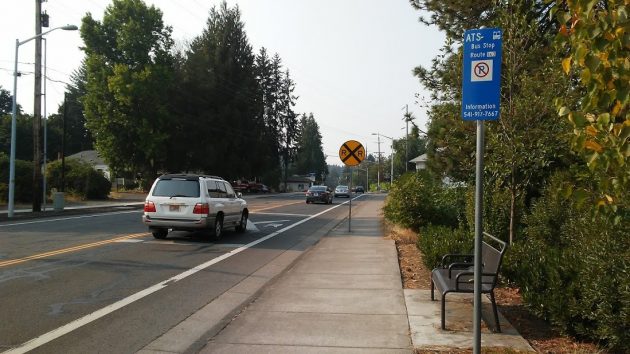
A lonely Albany Transit System bus stop on North Albany Road after hours on Monday evening.
If you ride the buses of Albany’s small Transit System, you may face even longer waits and have to walk farther to your job if changes now being discussed take effect.
The city buses covering their two one-way weekday circuits now hit each stop every 60 minutes, according to the published schedule. But they are often late.
Albany is working on a “transit development plan,” and on Monday the city council was asked to pick between two alternatives, a much-reduced route map that would keep the 60-minute plan, or a less reduced route plan in which buses would hit each stop only every 90 minutes.
The council voted 4-2 to go with the 90-minute scheme for planning purposes. When and how it would be carried out was left up in the air. There was talk that the city staff and consultant working on this would come back with a plan in several months.
Councilors Rich Kellum and Mike Sykes voted no. Kellum wants the city to consider raising the current $1 bus fare. Sykes thought it made no sense that the system was recovering only 5 percent of its cost.
Albany Transit, which is partly funded with federal grants, this year has a budget of $1.5 million, but that includes capital expenses. The city budget anticipates $25,000 in income from fares, down from about $30,000 in 2014-15. In addition to the two weekday routes, there’s a run early on weekday mornings. For the whole schedule and other details, go here.
From Monday’s discussion, I got the idea that the goal is a more “efficient” system that attracts more riders because of punctuality and sticking with a schedule.
Both alternatives presented to the council would reduce the number of areas served by bus stops. The 90-minute option, costing an estimated $659,000 a year in operations, would be less expensive than the 60-minute version and would reduce the service area less. Also, buses would run back and forth on the same route, so passengers would not have to tour half the town to get back to their starting point.
The scheme’s disadvantages would be irregular intervals between buses at stops, less frequent service to each area, and a “larger impact” on the number of jobs served within a quarter-mile of the routes.
There was some discussion Monday of the cost of the system compared to its use. Councilor Bill Coburn’s take was that it’s a city service that, like other services, everybody helps pay for whether they use it or not.
But here’s a question that might be worth asking, especially once you’ve seen hapless people without an alternative waiting for long periods at Albany bus stops in the summer heat or the winter rain: What if the city canceled the bus service and instead paid for taxi rides for everybody who needs one? If 25,000 people took the taxi at $10 each, the cost of $250,000 would still be far less than running buses on only two routes every weekday of the year. (hh)



Hasso, the problem with your taxi concept if enacted, “EVERYBODY” would “need ” a taxi at some point or another. Your suggested number of 25,000 people might be too low.
I wonder if they kept statistics before/after Route 2 dropped the downtown stop and added Wal Mart?
I ride the bus 1/4-1/3 as much as before, because it’s now a 2 hour round trip to go downtown. Before I could ride down on the #2, conduct my business (usually), catch the #3 bus 20 minutes later, transfer back to #2 at 32nd & Jackson and be back in 1 hour instead.of 2.
A 40-45 minute bike ride just made so much more sense at that point. The odds of getting wet are about the same as waiting 40 minutes for a bus.
Hey, hey, hey. That’ll be enough of that!!
“Because I said so” is the only thing you need to understand.
Now go back to your room, close the door, and hush up….
The taxi idea was just forming in my mind as you put it into words, Hasso. Good perspective. If it can’t pay for itself it’s not worth it. Granted, it’s a public utility, but in these days of ubiquitous private cars, a limited “call for service” system would likely be far more cost-effective.